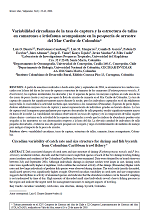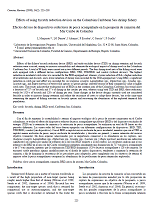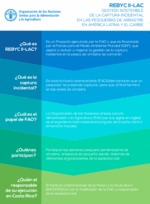
The effects of the introduction of bycatch reduction devices in the shrimp trawling fleet in shallow waters of the Colombian Pacific, were tested through a fishing experiment involving the industrial fishing sector. Following the commercial fishing conditions, we evaluated the turtle excluder device (TED), fish excluder device “fish eye” (OP)...
28/03/2018

Diel-associated changes of catch rates and size-structure of shrimp (Farfantepenaeus notialis and F. brasiliensis), incidental catches, discards and the twelve most caught fish species of each of the two shrimp trawling fishing zones (northern and southern) of the Colombian Caribbean Sea were examined. Data were obtained by on board observers between July and...
26/03/2018

Quantification of the tropical shrimp trawling impact and mechanics to reduce it on both Caribbean and Pacific Colombian coasts were evaluated. The methodological approach included census of the fishing technology, monitoring, workshops, trials and experiments. The census revealed that vessels and net designs are 30 years old. Fishing monitoring showed...
26/03/2018

In Colombia, industrial shrimp trawling has been carried out since 1958 on the Pacific coast and since 1969 in the Caribbean, generating income, foreign currency, food and employment for the fishing sector, but with a high environmental cost. In order to evaluate over time the impact of this fishery for...
26/03/2018

The technical characteristics of the shrimp trawl fleet operating in the Colombian Caribbean Sea,between Cartagena and Tolú were registered. There are 53 officially authorized vessels, 56.6%of them have Colombian registration and the 43.4% foreign one. The oldest vessels are 27years old and the newest ones began operations in 1991. The...
26/03/2018

Effects of the fisheye bycatch reduction device (BRD) and turtle excluder device (TED) on shrimp retention and bycatch reduction were assessed, aiming to increase sustainability and attenuate the ecological impact of shrimp trawls in the Colombian Caribbean Sea. A total of 88 hauls were carried out in two different periods. The four...
23/03/2018

The impact of the experimental introduction of a bycatch reduction device for juvenile fish inthe shrimp trawl fishery in the Colombian Caribbean was assessed for invertebrates. Four netconfigurations were compared: no device, turtle excluding device alone, bycatch reduction device for juvenile fish alone and both devices incorporated on the net. This...
23/03/2018

The increased recognition of the multiplicity of roles played by women in, and their crucial contributions to, the fisheries sector exists in stark contrast with the low presence of women in fisherfolk organizations around the globe, and the lack of access to decision-making positions in many formal fisheries-related organizations. This...
14/02/2018

One of the objectives of REBYC-II LAC is to carry out feasibility analyses of potential incentives, including eco-labels, for promoting and rewarding sustainable trawling practices among participating fisheries. In this paper published on Gulf and Caribbean Research, Antonio Di Cintio (REBYC-II LAC) and Luis Bourillón Moreno (Marine Stewardship Council) describe...
13/02/2018

El Flyer explica de que trata el Proyecto REBYC II-LAC (Gestión sostenible de la captura incidental en las pesquerías de arrastre de América Latina y el Caribe). Este es un proyecto ejecutado por la FAO y que es financiado por el GEF. Finalmente, el flyer incluye información sobre los marcos...
16/05/2017
